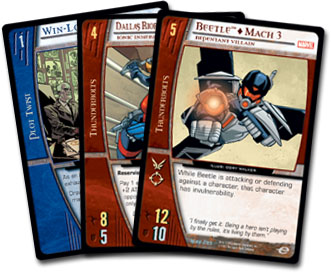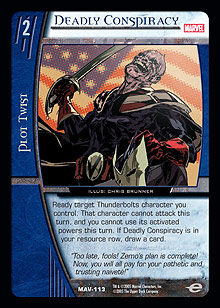
In the Avengers preview articles, we covered the origins of the set’s two new mechanics: leader and reservist. I thought it might be interesting to report on the back-story behind some of design directions for the Avengers teams.
Early in the design process for a new set, the Lead Designer reviews with the R&D group his ideas for mechanical identities for each of the new teams. Input for these ideas can come from a number of different sources.
The Lead can start by looking for design space that hasn’t yet been fully explored. This can come from focusing on a game effect or a card type, like the Gotham Knights excelling at card draw or the League of Assassins favoring locations. He can also decide to have a team identified with the set’s new mechanic. Avengers’ reservist and Green Lantern’s willpower are good examples of this integration. Design identities can also come from creating an atypical way to play the game, such as the X-Statix’s one-character build or the Squadron Supreme’s zero-hand deck.
Another element of team design direction is choosing whether or not to have the team feature one of the different deck archetypes—will the new team have an off-curve build, will it interact with concealed, and/or will it have powerful synergies when working with other teams? Designers can also look at the mechanics on the older teams and potentially expand on or re-feature them in the new set. For example, Brian Hacker introduced concealed to the game in the Marvel Knights set, and in the Green Lantern set, Danny Mandel expanded on it with the concealed-optional mechanic.
We also research comic history so we can feature mechanics that are thematic for the team. Willpower and constructs are at the heart of what it means to be a Green Lantern, and the Avengers are known for their iconic leaders and many reservists. After evaluating all of these areas, the Lead Designer selects a number of potential directions and then works with the R&D team to pick the final design identities.
When I was first thinking about directions for the Thunderbolts team, I had a number of conversations with Dan Scheidegger, who works on the Yu-Gi-Oh! R&D team. Dan is a huge Thunderbolts fan and has a complete collection of comics that he graciously lent to the creative team to help with art requests and flavor text.
I knew that I really wanted one of the Thunderbolts themes to play into their story of villains pretending to be heroes. Dan made the suggestion that the team might want to do something nice for the opposing team to try to prove that the Thunderbolts were actually heroes. The tension would be that the short term benefits these effects provide to the opponent would actually work out to the Thunderbolts’ advantage in the long run.
 I felt that this was an interesting direction and started to work with R&D to see how it could translate into a mechanical theme. In the end, this design cycle resulted in cards like Beetle, Mach 3; Dallas Riordan, Vantage; and Win-Lose Deal. These cards provided effects above the normal power levels for their costs at the disadvantage of providing the opponent with a benefit. It would be up to the players to figure out the best ways to exploit these advantages while minimizing or eliminating the benefits their opponents gained.
I felt that this was an interesting direction and started to work with R&D to see how it could translate into a mechanical theme. In the end, this design cycle resulted in cards like Beetle, Mach 3; Dallas Riordan, Vantage; and Win-Lose Deal. These cards provided effects above the normal power levels for their costs at the disadvantage of providing the opponent with a benefit. It would be up to the players to figure out the best ways to exploit these advantages while minimizing or eliminating the benefits their opponents gained.
The second major design direction for the Thunderbolts originated with Dave Humpherys during early R&D design discussions. Dave had commented on how he liked the way that previously released “growing” characters (like Beetle, Abner Jenkins and Silvermane, Silvio Manfredi) interacted in the game. He thought that the challenge of getting these characters to survive the early game so that they could become late game powerhouses was interesting enough to have a team feature that type of strategy.
Another observation made during these discussions was that in a typical curve game, players used the majority of their plot twists during the later turns. The group thought a creative way to introduce a new play pattern would be to reward playing plot twists early. Combining the two concepts, I set out to design a mechanical cycle with characters that grew over time and support effects that would both help them survive the early game and reward them in the late game. Ultimately, this resulted in the final text of Ogre, Weaponsmith; Beetle, Mach 2; Combat Maneuvers; and A Second Chance.
 So, what about the Thunderbolts cards that reward you for having ready characters, such as Mt.Charteris; Charcoal, Charles Burlingame; or David Humpherys’s favorite Avengers card, Deadly Conspiracy? This cycle actually evolved during the development process. In the initial file, there were only a few cards that interacted with this theme. During early testing, it was determined that these few cards didn’t have enough synergy with the other design directions but were exciting enough to be expanded into their own theme.
So, what about the Thunderbolts cards that reward you for having ready characters, such as Mt.Charteris; Charcoal, Charles Burlingame; or David Humpherys’s favorite Avengers card, Deadly Conspiracy? This cycle actually evolved during the development process. In the initial file, there were only a few cards that interacted with this theme. During early testing, it was determined that these few cards didn’t have enough synergy with the other design directions but were exciting enough to be expanded into their own theme.
Finally, from the “Oops” department, we wanted to own up to an error in the Avengers set. The card Justice, Like Lightning had a letter omission in the flavor text. The real passage from Thomas Randolph’s poem is:
If Justice, like Lightning,
Ever should appear,
To few men ruin,
But to all men fear.
Note that it’s “ruin,” and not “run” as printed on the card. This was a hard one to catch in editing, as a spellchecker or casual reader wouldn’t pick up on the error. Still, Danny Mandel takes full responsibility for the mistake and sincerely apologizes. If you send Danny your address at dmandel@metagame.com, he will arrange for Ben Seck to come to your house and apologize in person.